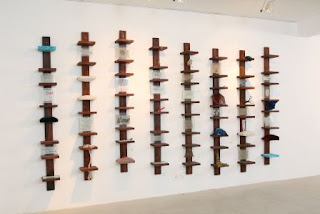Rakhi Peswani’s show at Vadehra Art Gallery does not seduce with lushness of fabric or embroidery. On the contrary, she presents an unusual perspective of sewing. It is its trivialness in everyday living that spurs the artist to pick up needle and thread. Her facility with the process is yet inept. She chooses to underline this, bringing our attention to awkward stitches offset by lofty ideas, generating questions and curiosity.
 |
| Rules of the Game |
 |
| As you Sew |
This is probably why the exhibition seems gauche and irksome. Rakhi Peswani hasn’t yet learned to communicate through the use of textiles. ‘On the Rules of the Game’ she attempts to address sexuality in saying “a stitch is also a prick”. She presents two hands in the process of sewing a maroon appliquéd velvet fabric, with these words sewn above using stitches reminiscent of marks made on fingertips as you sew. She attempts interplay on the sensation of being pricked while sewing and its reference to the masculine gender, without a convincing link. The fingers attempt a feeble penile reference but she needs to be more lucid about the connection she wishes to make, visually drawing this out in the work. Her idea appears diminished rather than augmented by the written word which seems to have been used to compensate lack of creativity.
 |
| Detail of 'As You Sew' |
Her preoccupation with cliché is evident throughout. In ‘As you Sew…’, multiple small shelves comprise a larger whole where she delineates ideas like ‘Slow’ or ‘Habit’ and ‘Desire’. Each of these are developed through the language of stitch, wherein ‘Slow’ employs chain-stitch, embroidering a snail-like ‘Slow’ and ‘Desire’ is evocatively sewn on disintegrating material as that which eats away the fabric of being. For ‘Habit’ she uses cross stitch, showing how repetition of something as inane as a stitch becomes a habit. Although these are small-scaled and don’t attempt grandiose statements, I found them most successful because here word and stitch complement each other.
In ‘Seductive Myths of Lightness (Sightscapes of an Insomniac) I’, I particularly like the way thread has been wrapped on wire, and the opened scissor pointed at an eye to present turmoil of a mind that cannot sleep. It is provocative, however if some of the threads encasing the wire armature had been left to hang loosely, they would have been more integral to the idea and not a mere prop. In addition, the canopy around this armature interferes with viewing. Eclipsed by over-lapping, semi-transparent panels of appliquéd patterns denoting the body, it is virtually closed on all sides so you are either looking inside the head or outside, unable to view the ‘sightscapes’ in totality. Squeezing yourself between the panels was not a convincing experience, leaving doubts about the need to define the anatomical body.
 |
| Misnomers - Heave |
The 'word' reappears again in ‘Misnomers’, to explain rather than intertwine with the visual to bring out the sub-text of meaning. ‘Breathe’, is presented with ‘hope’ drawn with safety pins and ‘Breathe’ neatly machine-sewed below, while two almost child-like lungs are presented above. She uses net, filled with cotton to represent lungs which end up looking like two pods hanging off a wooden stem, about to pop open. In ‘Heave” she uses a stuffed ready-made bra to evoke a female torso, gauchely presented with velvet in dark brown and ‘Heave’ appliquéd below, using cut-out lace. Here Rakhi overlooks associations of the bra in history of feminism, using it merely to represent the female torso but not as nude. Thus the work appears both gauche and confusing.
Most of the pieces in this exhibition reflect an air of carelessness despite lofty titles and clichés. Some of the imagery is strong, especially when she uses scissors, but after considered work [‘Being and Becomings…’], dressing them with gauze bandage and velvet and creating an elaborate assemblage of tiny brass safety-pins, which the scissors are poised to cut, Rakhi leaves the idea of the pillow as a torso fluidly developed, almost incomplete. She draws your attention and then lets you down, as if tired of working.
Textile making is a painstaking process, demanding commitment and dedication. Peswani’s ‘Intertwinings’ exhibit a lack of information and intimacy in working with the material but her inability to speak consummately cannot be attributed to this alone. Art making is the human response to our lives and the environment we exist in and Peswani falls short of a convincing dialogue because her experiences appear not to have touched her enough to provide insights to share with us.